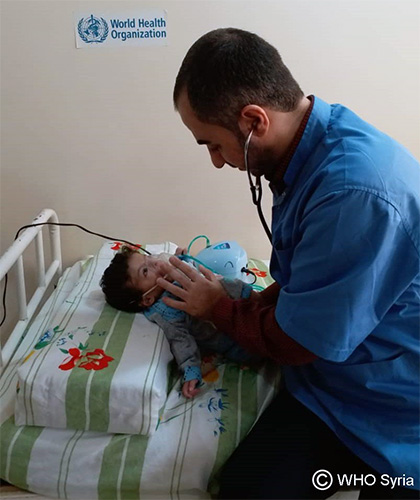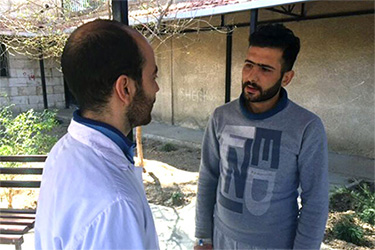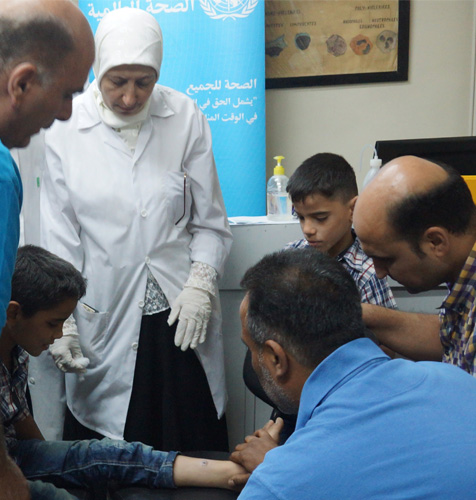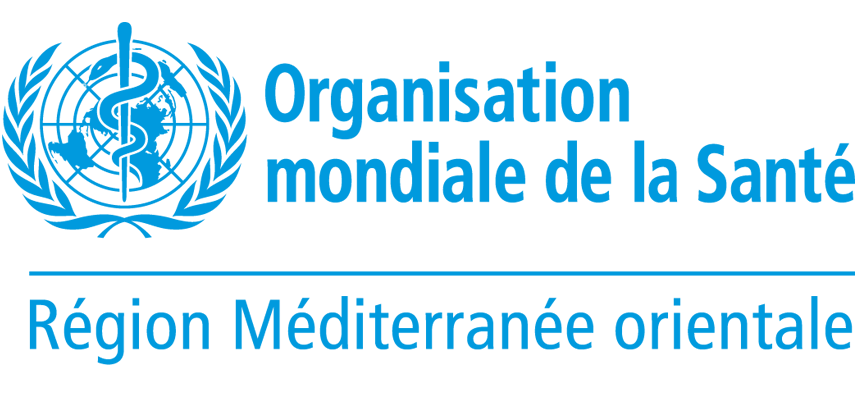Nutrition
The 2019 SMART survey revealed several pockets of emerging chronic and acute malnutrition. The survey confirmed that infant and young child feeding practices remained poor, with only 28.5% of mothers choosing early initiation of breast feeding. Similarly, only 18% of mothers exclusively breastfed their infants during the first six months of life. To date, 38 hospitals have been trained on the baby-friendly hospital initiative to increase the initiation of breastfeeding within the first hour of birth.
At the end of the year, the nutrition surveillance system consisted of a network of 827 health centres serving 980 000 beneficiaries. A total of 707 health facilities offered infant and young child feeding counselling, up from 592 in 2018. Three new stabilization centres for the treatment of SAM with medical complications were established in Aleppo, Al-Hasakeh and Ar-Raqqa, bringing the total number of centres supported by WHO to 25. In 2019, these centres treated 2145 children under the age of five, compared with 905 in 2018. The highest number of admissions was in Al-Hasakeh governorate (more than 650), reflecting the dire health status of children in Al-Hol camp who escaped ISIL’s last stronghold in early 2019. WHO is working with other UN agencies including UNICEF and WFP, both of which are supporting therapeutic and supplementary feeding programmes.
A total of 19 440 cases of global acute malnutrition (GAM) were detected and referred for treatment in 2019 (GAM means both severe acute and moderate acute malnutrition). The number of cases fluctuated only slightly compared with previous years. The 25 stabilization centres distributed across the country covered most needs but required regular support for nutrition therapeutic supplies, equipment and training of staff. Stabilization centres are still needed in Ar-Raqqa and Idleb.

Mental health
WHO and its partners have decentralized mental health care and increased community-based approaches. For example, trained and supervised doctors and health workers are providing integrated mental health care in over 540 PHC centres across the country. Two psychiatric wards in Lattakia and Damascus provide management for mental, neurological and substance use disorders. In the northeast, through close coordination with health partners, WHO continued to transport patients in acute need of special care to Aleppo mental health hospital.
In 2019, health partners across the country were provided with 121 202 treatment courses of psychotropic medicines, and 552 316 MHPSS services were delivered, often through local NGOs and innovative community-based methods. WHO trained Reproductive, maternal, newborn and child health services are critically important in humanitarian settings, which typically see increases in maternal deaths, unintended pregnancies, sexually transmitted infections, unsafe abortions and GBV. In 2019, most governorates showed considerable progress in providing these services. In 2018, 32 hospitals across the country had neonatal resuscitation programmes; psychosocial workers throughout Syria (including the northwest) on Problem Management Plus, a low-intensity psychological intervention that tackles depression, anxiety, problem-solving skills and resilience for adults.
WHO’s office in Damascus supported training for 725 physicians on mhGAP. Hundreds of health care workers were trained on basic, family and group counselling, psychological first aid and first-line support for GBV survivors. The learn–work–learn method applied helped to ensure that learning was translated into practice and reinforced at further training sessions. Additionally, 26 journalists were trained on communications around suicide prevention and MHPSS.
In northwest Syria, WHO supported 45 health facilities with regular supplies of mental health medicines and covered the operational costs of the acute inpatient unit in Sarmada mental health centre, as well as four mental health mobile clinics and a 24-hour telephone helpline. With the support of the Turkey Humanitarian Fund and the United Nations Office for the Coordination of Humanitarian Affairs, in 2019, this number rose to 38. The number of patients referred to specialized hospitals almost doubled, from 2821 to 5437. There was a similar rise in the number of mothers and newborns benefiting from home care (from 6361 in 2018 to 12 358 in 2019). An estimated 15% of deliveries and 15% of newborns will continue to require life-saving emergency interventions in 2020.


MHPSS services were integrated into 42 PHC centres, 32 mobile clinics, 20 hospitals and eight specialized centres. Overall, approximately 280 psychosocial workers now work in 118 facilities in northwest Syria that provide MHPSS services. WHO trained 945 humanitarian and community health workers on psychological first aid, enabling them to provide immediate support to the newly displaced and refer them for MHPSS. In addition, 28 mh-GAP-trained doctors in Afrin underwent six months of training, field supervision and coaching.
Late in 2019, WHO took over six non-specialized MHPSS services in northern Syria from an international NGO whose future was threatened by insufficient funds. Today, all six facilities are continuing to provide quality MHPSS services.
The school mental health programme, which was launched in 2018, continued in 2019. Teachers, counsellors and social and community workers in schools and community centres were trained on how to detect, help and refer children suffering from mental health disorders. WHO also developed a mental health preparedness plan for interventions in emergencies in the northeast and the northwest.
Humanitarian agencies are increasingly concerned about the potentially damaging effects of stress on services and staff performance. In northwest Syria, WHO provided stress management through a training-of-trainers programme and training on selfcare, peer support and coaching for 328 aid workers.
The outcome of WHO’s capacity building was reflected in the improved effectiveness and performance of Syrian health and community care providers, clearly documented in MHPSS care outcomes for IDPs, returnees and host communities.
WHO strengthened advocacy and coordination efforts by chairing an MHPSS technical working group with partners and stakeholders within Syria. Work with the ministries of health and education, other UN agencies and national and international organizations led to several agreements and work plans to enhance universal coverage for mental health and combat stigma and discrimination.
WHO’s efforts to gradually integrate mental health into the health care system in Syria have demonstrated the feasibility of not only delivering, but also expanding, mental health services in the midst of a protracted crisis while simultaneously aiming to reduce stigma and discrimination against people with mental health problems.
Measles
Despite access challenges, considerable success has been achieved in halting the spread of measles in Syria. In 2019, following a rise in the number of confirmed cases of measles in two consecutive years (2017 and 2018), WHO supported four mass measles vaccination campaigns to control the outbreak and strengthen routine immunization activities in all governorates. Only 27 cases of measles were confirmed in 2019, compared with 738 and 329 in 2017 and 2018, respectively.
In northern Syria, 716 suspected measles cases were reported in 2019, a figure 25 times lower than the 17 931 cases reported a year earlier. The highest numbers of suspected cases were from Idleb, Aleppo (northwest Syria) and Ar-Raqqa (northeast Syria). The significant decrease can be partly attributed to the two measles and rubella vaccination campaigns conducted in 2018 as well as increased routine immunization services in the northwest.

Leishmaniasis
Cutaneous leishmaniasis (CL) is endemic in Syria. This parasitic disease is caused by protozoa of the genus Leishmania, transmitted by the bites of sandflies. Transmission of the disease occurs during the sandfly season from May to September each year, but the lesions only begin appearing between October and December. In total, 89 357 cases of leishmaniasis were reported in all of Syria between January and December 2019. The northern governorates of Aleppo, Al-Hasakeh, Ar-Raqqa, Deir-ez-Zor and Idleb accounted for 94% of cases.
In northwest Syria, the number of new cases of CL rose sharply. One health cluster partner alone diagnosed and treated 17 653 new cases, representing an increase of 63% compared with 2018. The most affected areas were Idleb and Harim district in Idleb governorate followed by Jebel Saman in Aleppo governorate. WHO’s office in Damascus conducted 11 workshops on CL surveillance, management and diagnosis, and equipped 270 health workers and laboratory technicians in Aleppo, Al-Hasakeh, Damascus, Deir ez-Zor, Lattakia and Tartous with tools to tackle the spread of the disease. Nearly 70 000 insecticidetreated nets were delivered to Aleppo, Ar-Raqqa and Deir-ez-Zor, benefitting more than 200 000 people. WHO also provided 302 000 ampoules of meglumine antimoniate to treat approximately 60 000 leishmaniasis patients. WHO’s office in Gaziantep distributed 140 000 bednets, trained 1450 health care providers and provided medicines, instruments and materials for the indoor residual spraying of 182 000 households.




